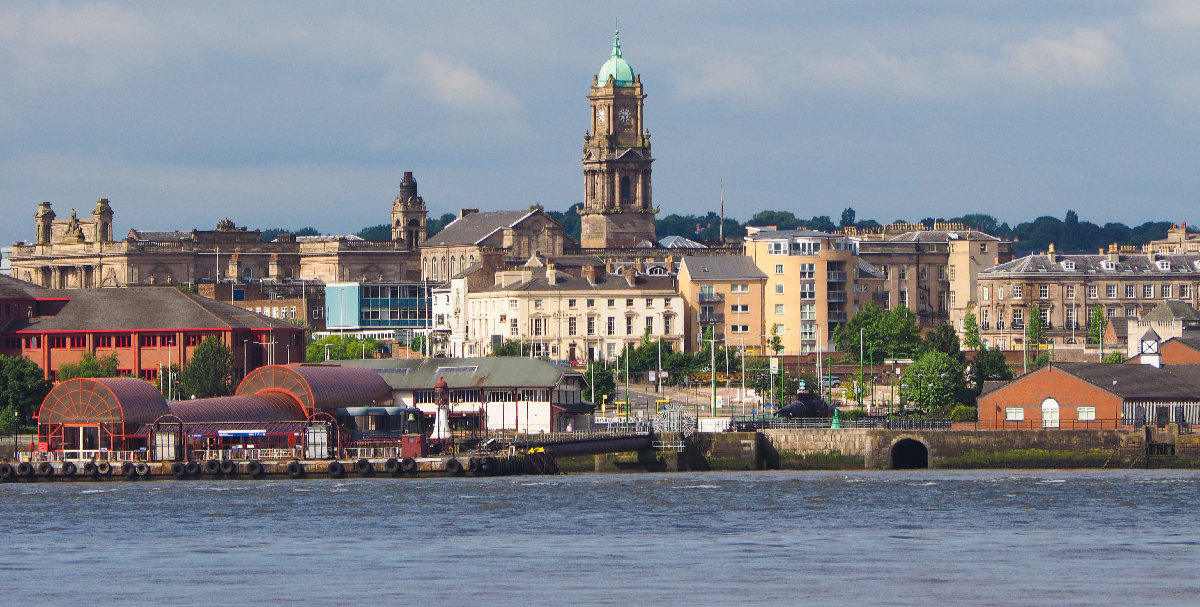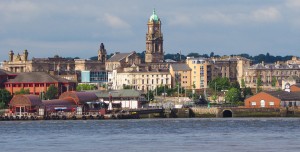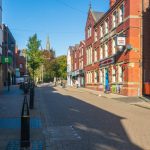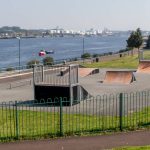
Join us for the Five Minute Spare’s Walk Round Birkenhead, everything you ever wanted to know about the town, and some stuff you weren’t that fussed about.

Image: Claudio Divizia/Shutterstock.com
Ok, dad joke aside let’s get Somewhere in Wirral, Merseyside, there is a town named Birkenhead. Within that town, hundreds of years of history lie wrapped in mystery for us to uncover. Birkenhead has about 90,000 people nowadays, but it wasn’t always thus.
Let’s talk about the history of this south bank of the Mersey town, then later move on to the attractions you might find there. 2021 is the year of the staycation, after all.
The Early Days of Birkenhead
Let’s start with the name. Bircen is the old word for a birch tree, with the ‘head’ part meaning that it is a headland… probably. The earliest recorded note of any town being there goes all the way back to Saxon England. In the middle of the twelfth century, it grew up around a Benedictine Priory. This means that it was around during the time of William the Conqueror’s invasion and that you can find it in the Domesday Survey.
The Domesday survey was a massive undertaking for its time. It was essentially the first ordnance survey carried out on English lands. It documented all the things that the new king had laid claim to when he occupied England. From farmland to churches, this was the only record of its kind for hundreds of years.
Now… this is where it gets interesting. During the 900s (ish) the Vikings raided all along the Mersey. They would have worked their way inland as far as nearby Wallasey at least. We managed to track down the record of their occupancy and a man named Uhtred was responsible for the lands in 1066. Later, this land would pass to the king. It includes 2 other population members, which we guess refers to the priory at Birkenhead. However, it is possible that there was nothing there but trees other than the priory.
As with all medieval priories, the town would have grown up around it. They piped water, brought travellers, and even spent coin, so monks were always welcomed unless they intended to set up a leper colony. These monks moved in around 1150, with their priory attracting not one, but two royal visits. Edward I visited in 1275 and again in 1277. His grandson would later allow the priory rights to establish the town.
Of course, let’s not forget about the impact Henry VIII had on the priories of Britain. Although the Bircen facility would have been prosperous and established the town, Henry VIII then abolished them all. So the Bircen priory set up a town before being ostracised by the kind in the 25th century. Although the town would have experienced a tourism surge after visits from the king, it shortly fell into degradation after Henry VIII’s rule. As such, the town was reduced to no more than a village, and thus it remained right up until the Industrial Revolution.
Let’s take that natural break in the story and gather round for some fun facts about Birkenhead.
Fun Facts about Birkenhead
If you are passing through, live there, or want to go on holiday there, Birkenhead fun facts are always handy to have up your sleeve. We tracked down a few to compile them into this list of Five Minutes Spare favourite fun facts, as follows:
- Nearby New Brighton was where the first shot of WWI was fired, using the guns mounted on the harbour.
- Containerisation, as they are calling the rollout of massive shipping containers, all but destroyed business at what used to be a bustling port in Birkenhead.
- The town is best known for shipbuilding contractor Cammell Laird, who is still in business to this day… nearly 300 years later.
- Birkenhead is sometimes known as “one eye city”. This is a reference almost lost to time. Some say it is because they only bothered to light one side of the highway, another is that the port workers often lost an eye. A third suggests that their clock face only had one working face. Whatever the reason, Birkenhead remains one eye city.
- The Mersey Ferry started running from here in 1150… and is still running to this day. Obviously, they upgraded the boat…
There are some cool things about this town that anyone can enjoy learning. Now that we are through the fun stuff, let’s jump back into the Industrial Age.
The Industrial Revolution in Birkenhead
Right up until the steam ferry became a thing, Birkenhead remained a farming town. In 1817 that all changed, of course, and the industrial revolution spread across the river from Liverpool. In 1822 the first paddle steamer joined the fleet, with the railway finally opening in 1840. It wasn’t until late in the same century that the rail tunnel under the river could be built, thus fully connecting the town to Liverpool.
In 1829 the first shipbuilding year opened and started churning out ships. The HMS Affray and Achilles came from Birkenhead port. So did the HMS Birkenhead, HMS Caroline, the CSS Alabama, the HMS Theris, the HMS Conqueror, HMS Prince of Wales, RMS Mauritania, and RMS Windsor Castle, all came from this shipbuilding yard.
1821 saw St. Mary’s Church go up, with enough of a population now to constitute its own parish. In 1824, William Laird (local hero) instituted a New Town of Birkenhead. By 1833 they had a town council and the streets were being paved and cleaned. They may well have been lit too, but it would have been via gas lamp right up until the electricity advent in the early 1900s.
In 1842 an entire gasworks was built to accommodate the growth in town brought about by the railway. A market hall was added in 1845 so that the produce could move indoors for trade. A yearly fair was held, as well as regular market days. Birkenhead became a centre for trade in the early parts of the Industrial era.
The docks opened formally in 1847, although ships were already being built from here. 1856 saw the addition of a national post office, further solidifying the connection the townsfolk had with the outside world. It is estimated that there were something close to 35,000 people living in Birkenhead by the 1860s… a figure that hasn’t truly stopped growing since.
It would be a further thirty years before electricity replaced the average street lamp. In 1901 the recorded population had more than doubled, thanks to the river, train track, and incorporation as a New Town. The downside of all this was that there was mass unemployment in an impoverished city. There weren’t many industries in town and they didn’t have much to trade when that farmland was gradually eroded. All that was left was port work, and if you stayed on the outskirts, not even that.
There were huge areas of slum territory as a result. The last trams ran in 1937 after gradual replacement with buses, and the Mersey Tunnel for traffic opened in 1934. This allowed for Birkenhead to become a true commuting town, easing the burden of unemployment in the area. A library was added for the public in 1931, only a few short years before the Second World War saw Birkenhead bombed… probably by mistake as the planes headed for Liverpool.
Two World Wars in Birkenhead
The massive unemployment that led the town into the First World War was bound to see thousands of young men sent to their deaths. In those days, the government called young men up in their droves, conscripting them to do their national service. The men would be sent away as one group, with whole regiments being created in the same area. This meant that whole towns’ worth of young men were wiped out in the trenches. When they did come home, it would be to empty towns and grieving sweethearts.
If anything, World War II was worse. It saw the town itself being bombed since it lay across the river from Liverpool. A memorial is held in the Birkenhead Town Hall to this very day, to remember those casualties that never made it home. The Birkenhead Institute was set up to train officers, and Wilfred Owen, the famous war poet, attended this. Underneath the town, there are circuits of underground tunnels used as air-raid shelters. You can still visit it today. The entrance is in Tranmere.
Naturally, as a port town and shipbuilder, there was a lot of activity in the area in each world war. It is possible the Germans bombed it because of the ship building port. It is equally as likely that they misplaced their bombs. Whatever the reason for it, civilians were killed, houses were rebuilt, and, when everyone came back home and the war was over, the slums turned into council housing estates.
Modern Day Birkenhead
Since the second world war, Birkenhead has continued to grow, although now at a more measured pace. Just before it, in 1932, unemployed people were staging protects for living conditions. There were even riots in the streets! After it, the population had lessened somewhat and there was less of a demand for work. The rioting lasted for three days and was only successfully stopped when police were called in from surrounding areas to help moderate the situation.
In 1934, the Queensway Road Tunnel was opened as a new passage to the country beyond the river. This added to the industrialisation of the town and brought new work for some. After WWII however, men returned to new council estates and a borough that was switching hands. In the end, they became part of Cheshire.
Shipbuilding still managed to prosper in the post-war era. It started to decline in the 70s and 80s but has evened out over time. The arrival of the shipping container did a lot of damage but didn’t slow it completely. They are one of the few shipbuilders left in England.
By 1951 the population of Birkenhead was the highest it had ever been, at around 145 thousand people. When the shipbuilding industry died down, so did the population. A technical college was added in 1955 and the hospital was opened in 1982. At the beginning of the 1990s, the docks were refurbished to become a place of historical interest. The population teetered out to become nearly 90,000… more than 50,000 people less than in its heyday.
Another notable occasion was in 1981 when a tornado is recorded as having come to town… as unlikely as that may seem for middle England…
Nowadays Birkenhead is a bustling industrial metropolis with plenty of sea access and a lot of dock workers. It has some heritage attractions, some old ruins to explore, and a great handle on its cultural identity. It is the town of the hard worker, built on the sweat and tears of those who have gone before us. They have a heritage that brings a tear to the eye of even the laziest of us.
Next up, we are going to examine who the most famous people to have come from the town are, to give you a better idea of what the Northern Attitude is like.
Famous People from Birkenhead
Birkenhead has had more than its fair share of famous faces. We dug out a few Five Minutes Spare favourites for you to enjoy:
- Pete Burns, from the band Dead or Alive, was from The Wirral.
- John Bowe, the actor, and curiously several of the Brookside actors.
- Daniel Craig – The Daniel Craig Himself – is from here.
- Taron Egerton, who was in Kingsman.
- Dominic Purcell, who played Lincoln in Prison Break, was a Birkenhead boy.
There are plenty of other famous people from the Wirral peninsula. You can have a browse through some for yourself, here.
Birkenhead Attractions
So if you are destined for a week off spent in Birkenhead this summer, what should you get up to? We listed the best of Birkenhead attractions for you to choose from, right here.
Historic Sights and Landmarks
You can see the spire of Birkenhead Priory from all over the city. It was one of the few priories that weren’t removed, stone by stone, when Henry VIII closed them down and is well worth a visit. It is the oldest building in town by far and would once have been the very centre of the activity.
The Birkenhead Central Library is a well-known tourist photo stop. If you want a photo for your Instagram that really says you have been to Birkenhead – this is where you get it from. You can even use the library to learn a bit about the history of the town, read a book, or track down your ancestry.
There are two massive churches forming the backdrop of the Birkenhead skyline, asides from the spire on the priory. St. Saviours Church, in Oxton, is massive and still runs services. You can also catch a service at St. Joseph’s Roman Catholic Church, in the area too.
Galleries and Museums
Moving away from the iconic landmarks, let’s talk galleries and museums. In fact, and rather surprisingly for an English town, we have an Art Gallery as the top voted Trip Advisor attraction. The Lady Lever Art Gallery is a gorgeous building with a beautiful water fountain out front. Go along and have a peek, it’s stunning in summer!
Next, one of the best-loved museums on this side of the Mersey is the Wirral Transport Museum and Heritage Tramway. The old electric trams are still styled in the green-and-beige of the 1900s. The museum is run mostly by volunteers but contains a wealth of transportation types that kids adore. Get in the driving seat of a fire engine or hit the horn of a tram.
Let’s not forget about the Williamson Art Gallery and Museum, which contains most of the history of the region. This is a great day out for those that adore art, and a tranquil, serene space in the centre of the bustling town. Peruse the exhibits, love some fine art, then pick up gifts in the shop.
Outdoor Attractions
Let’s start this round with the Birkenhead Tramway. Even if you don’t want to go to the museum, you should still have the chance to enjoy one of these fabulous old world trams first-hand. It was opened in 1995 by the town council and the project was helped along by the museum. The trams are double-decker so you can get around town and feel like you are flying, all at once.
A second favourite outdoor attraction in town is Birkenhead Park. A large, gated park, this place is part place to sunbathe, part place to meet your friends and part gardens. There is a pond, a boathouse, a Swiss Bridge, and a lot of wildlife to enjoy.
There is an urban farm in town, which features a petting zoo and an arable area, as well as a play area. This enticing outdoor activity centre has loads to do for kids, harkens back to the town’s foundation as a farming town, and teaches young ones how to take care of animals and grow their own food. It’s an important place that you should definitely visit. It’s called the Tam O’ Shanter Urban Farm and we can’t think why.
Sports and Recreation
There are a number of football teams in the area but, let’s face it, with Liverpool FC across the water that’s who most support. The Tranmere Rovers are in town and the Cammell Laird 1907 football club is another firm favourite.
In terms of golf, you are absolutely spoiled for choice. Check into the Bromborough Golf Club, the Prenton Golf Club, the Wirral Golf Club, or the Wallasey Club. The town is also well known in the rugby field, under the team name Birkenhead Park Rugby Club.
Shopping and Retail
Those that want to shop till they drop will enjoy the Pyramids shopping centre. It has just about everything you need. There are plenty of good shops in the town centre, too. If you are still lacking, you can pop over the river to Liverpool for the afternoon, it’s not far.
Other Notable Attractions in Birkenhead
We are at the stage where we have covered just about everything we can think of to cover out of the Birkenhead city area. That being said, there are a few other favoured attractions that we just didn’t have the space to fit in. Some of our other favourites that didn’t quite make it, include the following attractions…
- Visit the Tranmere Rovers stadium to catch a game.
- Take a tour of the Glen Affric brewery… adults only, we’re afraid.
- Catch a show at the Little Theatre, which is just as little as it sounds.
- Stop by Europa Pools to do some swimming or use their sports halls.
- Go antiquing at the Amorini Antiques Centre on Sunday.
There is something for the whole family when you visit Birkenhead. Better yet, if you can’t find what you want to do, you have access to the entirety of Liverpool’s attractions, too.
How to get to Birkenhead?
You are just about up to speed on everything we know about the happy little town of Birkenhead here. The last thing we have to tell you is how you go about getting there. Enjoy!
By Road
Head west out of Liverpool and cross the river, you won’t be able to miss it.
By Rail
You have two choices: Birkenhead Central or Hamilton Square Station.
By Air
Liverpool Airport is not more than twenty miles away.
By Sea
Head for the port at Birkenhead for sea access. You can also go up the River Mersey if your boat is capable.


